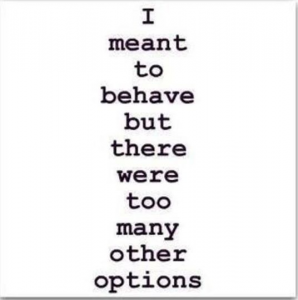 Continuing posts for the newbies, mostly at the middle school and high school level
Continuing posts for the newbies, mostly at the middle school and high school level
New teachers often hesitate to seek outside help with disciplinary issues. They understandably worry about making a bad first impression. For any teachers out there who are afraid to call in the cavalry, this post is for you.
You must ask for help with some issues. Actions at the start of the year establish precedents. Inactions also establish precedents — and you can end up struggling with misbehaviors for the rest of the school year if you roll over in September. My young colleague who rationalized that “dumb-ass” was not “really a curse word” and let a student in her class effectively off the hook after an example of outrageous disrespect?She was let go the following year, mostly due to subsequent disrespectful student behavior. That kid who cursed at you? That kid MUST receive a consequence. His or her fellow students need to see you will not be a pushover. Parents or guardians should also receive a phone call.
Maybe you are afraid that reporting misbehavior will be interpreted as being unable to manage your classroom. That fear has to be ignored when the cause is sufficient. Frankly, if you never feel comfortable asking for help from your administration, the problem is your administration — not you — and you may want to look for another school district.
Regardless, disrespectful and disruptive behaviors must be shut down as much as possible and as early as possible during the school year. That sometimes requires reporting a problem even if you would rather not have the Dean know that “Matt” called you a @#%@%. In science fiction terms, you do NOT want to live in the parallel universe where “Matt” got away with calling you that name because you will be absolutely miserable in that universe, as “Matt” keeps pushing to find the boundaries and get another laugh at your expense.
You should have a referral form to use in case of trouble. If it’s like many other forms, the misbehaviors on the following list call for immediate referral to the Dean or other administrators in the disciplinary pipeline:
♦ Drugs
♦ Fighting — this includes serious verbal altercations as well as physical assaults
♦ Harrassment, intimidation or bullying of other students
♦ Horseplay meant to disrupt class or horseplay that does not stop when you say stop
♦ Some forms of insubordination — this can be tricky…
♦ Possession of weapons or look-alike weapons
♦ Profanity or serious verbal disrespect toward the teacher
♦ Refusing to identify yourself (This tends to be hallway issue.)
♦ Skipping class or extreme tardiness
♦ Smoking
♦ Vandalism
In a sense, most of the above behaviors are often easier to manage than less serious infractions. Recreational drug use is simply unacceptable. Possession of weapons cannot be tolerated. Kicking over a desk or gouging a crown into its surface cannot be ignored or excused. That crown requires an immediate referral. If the idea of the crown did not immediately ping your gang activity warning bells, you might also talk to colleagues about gang activity in your area.
The flip side of what I have written above is that a new teacher’s instinct not to write referrals may be spot on. Too many referrals can put you in the spotlight, and you want to avoid that. Beyond the items on the above list, disciplinary referrals tend to become more discretionary, and I’d suggest avoiding referrals when possible. Fairly or unfairly, referrals can raise classroom management concerns, and they also give away some of your own personal power. Kids sometimes view referrals as a version of, “Wait till (another authority figure) gets home (to take charge)!!
One five-minute tardy will probably not be worth the paperwork, especially since administrators tend to be too busy to manage what they perceive as trivial problems. Three tardies in a week make a different story, though. Attitude should be a determining factor in the referral process. Was the behavior deliberately disruptive? That’s probably a referral, but you might want to handle disruptive behavior yourself. Did the student intend to swear? Sometimes words just slip out. Did the horseplay spill over into class from the passing period? You may be able to address that horseplay with a short reminder about the rules and a small consequence such as cleaning the classroom before school. Littering and pencil doodles on desks call for natural consequences such as desk-cleaning duty. Afterschool and lunch detentions act as deterrents for other behaviors.
Misbehaviors I would recommend tackling on your own before issuing referrals include the following:
♦ Academic dishonesty
♦ Bothering other students short of bullying
♦ Breaking school rules (a few rules call for immediate referrals, especially when safety issues are in play)
♦ Cursing not directed toward you that is not bullying
♦ Disruptive behavior that continues after you bring the behavior to a student’s attention
♦ Horseplay
♦ Huggy kissy stuff — PDAs
♦ Littering
♦ Property misuse
♦ Tardiness
Eduhonesty: I’ll pick up this thread again in the next day or two. I’ve launched into a huge topic and a complicated one. My advice might be quite different for District 43 than for District 182, for example. Who are your administrators? How much experience do those administrators have within your district? Who will help?
I will end today’s post with a familiar piece of advice: Ask your mentor teacher or other experienced teachers within your district how to manage your disciplinary challenges. I favor lunch and afterschool detentions myself, but whatever you do, don’t let deliberate disrespect go. You may want to call home, talk to parents or guardians, and issue your own consequence — rather than discussing disrespect with others outside the classroom — but your “Matts” must be stopped before their behaviors escalate, both for your sake and for theirs.


 I am grateful to my readers, the kids I met this year, and all the people who keep struggling to get education right. I am so glad for all of you, for the people who know that fish don’t belong in trees, and who are trying to make school work for our many kids, all our kids with their different talents, interests and inclinations.
I am grateful to my readers, the kids I met this year, and all the people who keep struggling to get education right. I am so glad for all of you, for the people who know that fish don’t belong in trees, and who are trying to make school work for our many kids, all our kids with their different talents, interests and inclinations.

